A correct Lewis structure will show which atoms are bonded to which other atoms and account for all of the valence electrons. A Lewis structure may be adapted to show the shape of the molecule, but the molecular shape is not necessarily shown in a Lewis structure. We use Valence Shell Electron Pair Repulsion theory to predict the shape of the molecule from its Lewis structure.
What is the molecular geometry (shape) of I 3 − ?
- Trigonal planar
- Trigonal bipyramidal
- Bent
- Linear
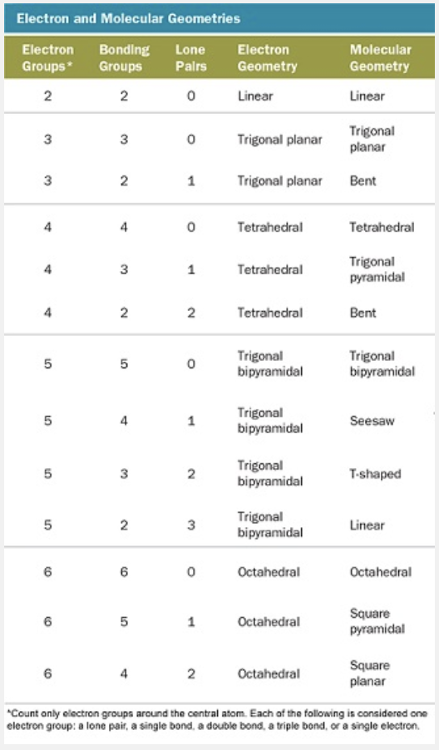
Linear
Ex.
The molecular geometry of I 3 − is linear . A molecule with two bonded atoms and three lone pairs on the central atom will assume a linear molecular geometry and a trigonal bipyramidal electron geometry.
A molecule with three bonded atoms and no lone pairs on the central atom will assume a trigonal planar electron and molecular geometry. A molecule with two bonded atoms and one lone pair on the central atom will assume a trigonal planar electron geometry and a bent molecular geometry.

Consider the Lewis structure of carbon dioxide.
What type of hybridization is found on carbon in CO 2 ?
- sp3d
- sp3
- sp
- sp3d2
- sp2
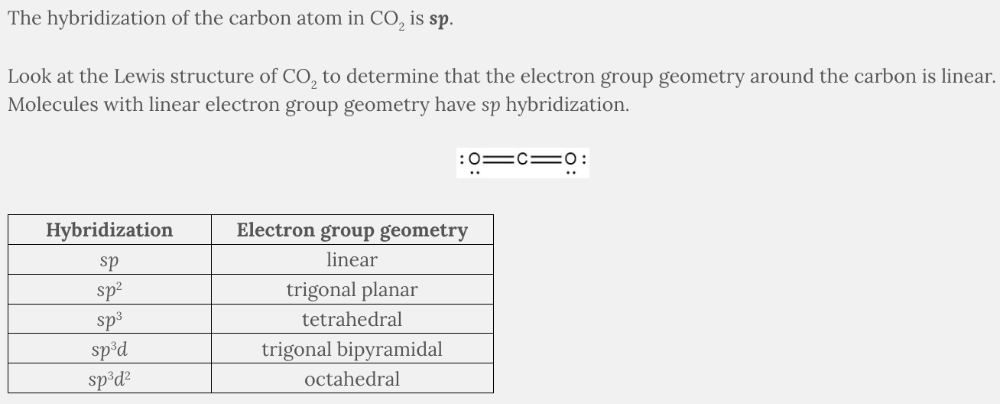
sp
A correct Lewis structure will show which atoms are bonded to which other atoms and account for all of the valence electrons. A Lewis structure may be adapted to show the shape of the molecule, but the molecular shape is not necessarily shown in a Lewis structure. We use Valence Shell Electron Pair Repulsion theory to predict the shape of the molecule from its Lewis structure.
What is the molecular geometry of H 2 O?
- Bent
- Trigonal planar
- Tetrahedral
- Linear

Bent
Ex.
The molecular geometry of H 2 O is bent . A molecule with two bonded atoms and two lone pairs on the central atom will assume a tetrahedral electron geometry and a bent molecular geometry.
A molecule with two bonded atoms and no lone pairs on the central atom will assume a linear electron and molecular geometry. A molecule with three bonded atoms and no lone pairs on the central atom will assume a trigonal planar electron and molecular geometry. A molecule with four bonded atoms and no lone pairs on the central atom will assume a tetrahedral electron and molecular geometry.

Bond orders are calculated from the numbers of electrons in bonding and antibonding orbitals.
The bond order provides a measure of the stability of a bond. Select the true statement.
- The higher the bond order, the more stable the bond.
- A bond order of zero indicates a stable bond.
- The lower the bond order, the more stable the bond.
- A negative bond order indicates a stable bond.
The higher the bond order, the more stable the bond.
Ex.
The higher the bond order, the more stable the bond.
Bond orders are calculated from the numbers of electrons in bonding and antibonding orbitals. The values are always positive; and the higher the value, the more stable the bond. Bond orders of zero are unstable and indicate that a bond will not form. Bond orders cannot be negative because the number of electrons in bonding orbitals will always be equal to or more than the number of electrons in antibonding orbitals.
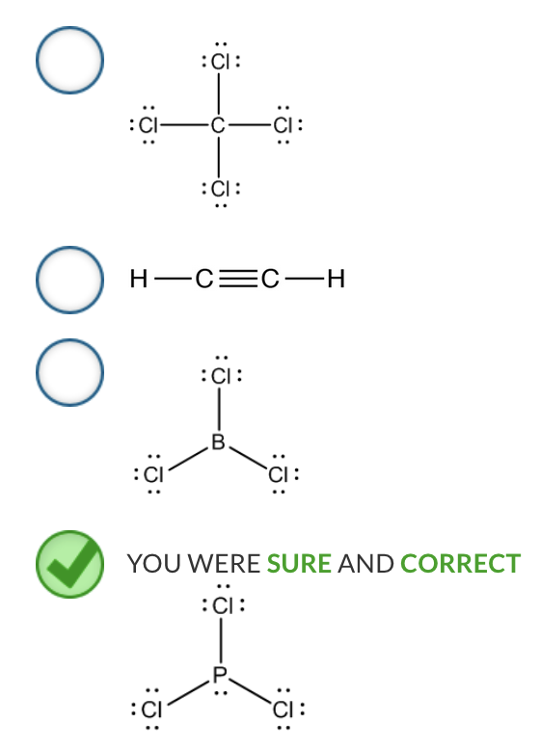
A correct Lewis structure will show which atoms are bonded to which other atoms and account for all of the valence electrons. A Lewis structure may be adapted to show the shape of the molecule, but the molecular shape is not necessarily shown in a Lewis structure. We use Valence Shell Electron Pair Repulsion theory to predict the shape of the molecule from its Lewis structure.
Choose the molecule that is polar.
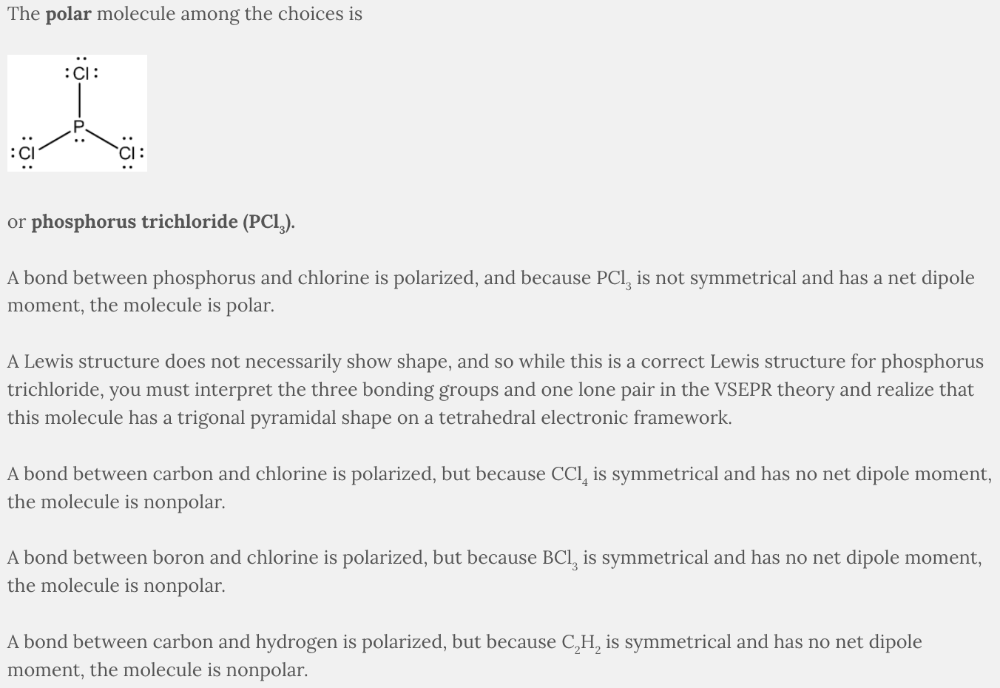
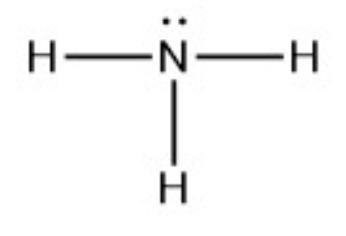
Consider the Lewis structure of ammonia, NH3.
What type of orbitals overlap to form the N-H bond in NH 3 ?
- p of nitrogen and s of hydrogen
- sp2 of nitrogen and s of hydrogen
- s of nitrogen and s of hydrogen
- sp3 of nitrogen and s of hydrogen
sp 3 of nitrogen and s of hydrogen
Ex.
The N-H bond in NH 3 is formed from the overlap of an sp 3 orbital of nitrogen and the s orbital of hydrogen .
The nitrogen in NH 3 has a tetrahedral electron group geometry and sp 3 hybridization. The sigma bond between nitrogen and hydrogen is formed from the overlap of a hybrid sp 3 orbital of nitrogen and the half-filled s orbital of hydrogen.
What electron geometry is associated with sp 3 hybridization?
- Octahedral
- Trigonal bipyramidal
- Tetrahedral
- Linear
- Trigonal planar

Tetrahedral
A correct Lewis structure will show which atoms are bonded to which other atoms and account for all of the valence electrons. A Lewis structure may be adapted to show the shape of the molecule, but the molecular shape is not necessarily shown in a Lewis structure. We use Valence Shell Electron Pair Repulsion theory to predict the shape of the molecule from its Lewis structure.
What is the molecular geometry of SO 3 ?
- Seesaw
- Trigonal pyramidal
- Trigonal planar
- T-shaped

Trigonal planar
Ex.
The molecular geometry of SO 3 is trigonal planar . A molecule with three bonded atoms and no lone pairs on the central atom will assume a trigonal planar molecular geometry.
A molecule with three bonded atoms and one lone pair on the central atom will assume a tetrahedral electron geometry and a trigonal pyramidal molecular geometry. A molecule with four bonded atoms and one lone pair on the central atom will assume a trigonal bipyramidal electron geometry and a seesaw molecular geometry. A molecule with three bonded atoms and two lone pairs on the central atom will assume a trigonal bipyramidal electron geometry and a T-shaped molecular geometry.
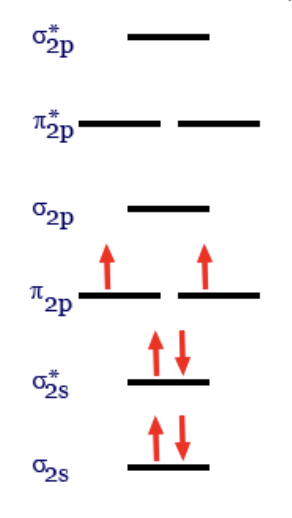
There are six valence electrons in the homonuclear diatomic molecule B2. Molecular orbital theory predicts the following occupation of the orbitals.
Is B 2 diamagnetic or paramagnetic? Why?
- B2 is paramagnetic because all of its electrons are paired.
- B2 is diamagnetic because all of its electrons are paired.
- B2 is diamagnetic because it has unpaired electrons.
- B2 is paramagnetic because it has unpaired electrons.
B 2 is paramagnetic because it has unpaired electrons.
Ex.
B 2 is paramagnetic because it has unpaired electrons .
Paramagnetic substances have unpaired electrons, whereas diamagnetic substances have all of their electrons paired. The molecular orbital diagram of B 2 shows two unpaired electrons, indicating the substance is paramagnetic and will be attracted to a magnetic field.
A correct Lewis structure will show which atoms are bonded to which other atoms and account for all of the valence electrons. A Lewis structure may be adapted to show the shape of the molecule, but the molecular shape is not necessarily shown in a Lewis structure. We use Valence Shell Electron Pair Repulsion theory to predict the shape of the molecule from its Lewis structure.
The molecular geometry (shape) of BeH 2 is __________.
- Trigonal planar
- Linear
- Bent
- Trigonal pyramidal

Linear
Ex.
The molecular geometry (shape) of BeH 2 is linear . A molecule with two bonded atoms and no lone pairs on the central atom will assume a linear electron and molecular geometry.
A molecule with three bonded atoms and no lone pairs on the central atom will assume a trigonal planar electron and molecular geometry. A molecule with two bonded atoms and one lone pair on the central atom will assume a trigonal planar electron geometry and a bent molecular geometry. A molecule with three bonded atoms and one lone pair on the central atom will assume a tetrahedral electron geometry and a trigonal pyramidal molecular geometry.
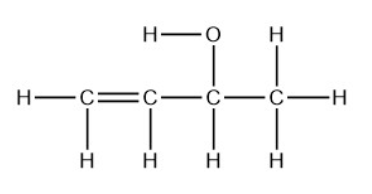
How many ơ and π bonds are found in 3-buten-2-ol?
- 12 ơ and 2 π
- 12 ơ and 1 π
- 13 ơ
- 11 ơ and 2 π
12 ơ and 1 π
Ex.
There are 12 ơ bonds and 1 π bond in 3-buten-2-ol.
A single bond is a ơ (sigma) bond, a double bond is composed of one ơ and one π (pi) bond, and a triple bond is composed of one ơ and two π bonds. The molecule contains eleven single bonds and one double bond. Eleven single bonds are eleven ơ bonds and the double bond is one σ bond and one π bond for a total of 12 ơ bonds and 1 π bond.
Which statement is true?
- There is no connection between the number of standard atomic orbitals and the number of hybrid atomic orbitals.
- The number of hybrid atomic orbitals made equals the number of standard atomic orbitals used.
- The number of standard atomic orbitals is greater than the number of the hybrid atomic orbitals.
- The number of standard atomic orbitals is less than the number of hybrid atomic orbitals.
The number of hybrid atomic orbitals made equals the number of standard atomic orbitals used.
Ex.
Hybrid atomic orbitals form from standard atomic orbitals, and when they do, the number of hybrid atomic orbitals made equals the number of standard atomic orbitals used.
Hybrid orbitals are a mathematical combination of standard atomic orbitals. The use of hybrid atomic orbitals provides a better explanation of bonding for many molecules than the overlap of standard atomic orbitals.
A correct Lewis structure will show which atoms are bonded to which other atoms and account for all of the valence electrons. A Lewis structure may be adapted to show the shape of the molecule, but the molecular shape is not necessarily shown in a Lewis structure. We use Valence Shell Electron Pair Repulsion theory to predict the shape of the molecule from its Lewis structure.
What is the electron geometry of BrF 5 ?
- Square pyramidal
- Trigonal bipyramidal
- Octahedral
- Square planar

Octahedral
Ex.
The electron geometry of BrF 5 is octahedral . A molecule with five bonded atoms and one lone pair on the central atom will assume an octahedral electron geometry.
A molecule with five bonded atoms and no lone pairs on the central atom will assume a trigonal bipyramidal electron and molecular geometry. A molecule with four bonded atoms and two lone pairs on the central atom will assume an octahedral electron geometry and a square planar molecular geometry. A molecule with five bonded atoms and one lone pair on the central atom will assume an octahedral electron geometry and a square pyramidal molecular geometry.
A correct Lewis structure will show which atoms are bonded to which other atoms and account for all of the valence electrons. A Lewis structure may be adapted to show the shape of the molecule, but the molecular shape is not necessarily shown in a Lewis structure. We use Valence Shell Electron Pair Repulsion theory to predict the shape of the molecule from its Lewis structure.
What is the electron geometry of PCl 5 ?
- Octahedral
- Tetrahedral
- Trigonal bipyramidal
- Square pyramidal

Trigonal bipyramidal
Ex.
The electron geometry of PCl 5 is trigonal bipyramidal . A molecule with five bonded atoms and no lone pairs on the central atom will assume a trigonal bipyramidal electron geometry.
A molecule with four bonded atoms and no lone pairs on the central atom will assume a tetrahedral electron and molecular geometry. A molecule with six bonded atoms and no lone pairs on the central atom will assume an octahedral electron and molecular geometry. A molecule with five bonded atoms and one lone pair on the central atom will assume an octahedral electron geometry and a square pyramidal molecular geometry.
A correct Lewis structure will show which atoms are bonded to which other atoms and account for all of the valence electrons. A Lewis structure may be adapted to show the shape of the molecule, but the molecular shape is not necessarily shown in a Lewis structure. We use Valence Shell Electron Pair Repulsion theory to predict the shape of the molecule from its Lewis structure.
What is the electron geometry of XeF 4 ?
- Tetrahedral
- Square pyramidal
- Octahedral
- Square planar

Octahedral
Ex.
The electron geometry of XeF 4 is octahedral . A molecule with four bonded atoms and two lone pairs on the central atom will assume an octahedral electron geometry.
A molecule with four bonded atoms and no lone pairs on the central atom will assume a tetrahedral electron and molecular geometry. A molecule with five bonded atoms and one lone pair on the central atom will assume an octahedral electron geometry and a square pyramidal molecular geometry. A molecule with four bonded atoms and two lone pairs on the central atom will assume an octahedral electron geometry and a square planar molecular geometry.
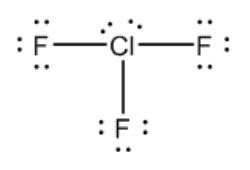
A correct Lewis structure will show which atoms are bonded to which other atoms and account for all of the valence electrons. A Lewis structure may be adapted to show the shape of the molecule, but the molecular shape is not necessarily shown in a Lewis structure. We use Valence Shell Electron Pair Repulsion theory to predict the shape of the molecule from its Lewis structure.
Consider the molecule chlorine trifluoride shown here:
Is ClF 3 a polar, nonpolar, or ionic compound?
- Nonpolar
- Polar
- Ionic
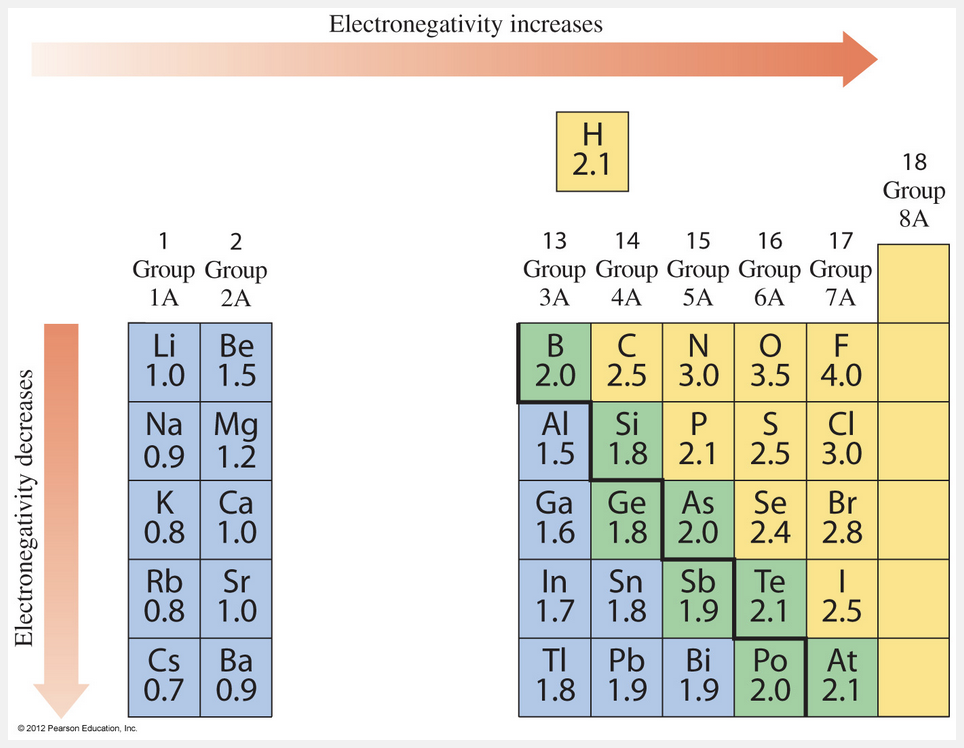
Polar
Ex.
ClF 3 is a polar compound.
The Cl-F bonds are polar because of their difference in electronegativity values. Due to the molecular geometry (shape) of the molecule, which is T-shaped, the polarity of the bonds results in a net dipole moment for the entire molecule.
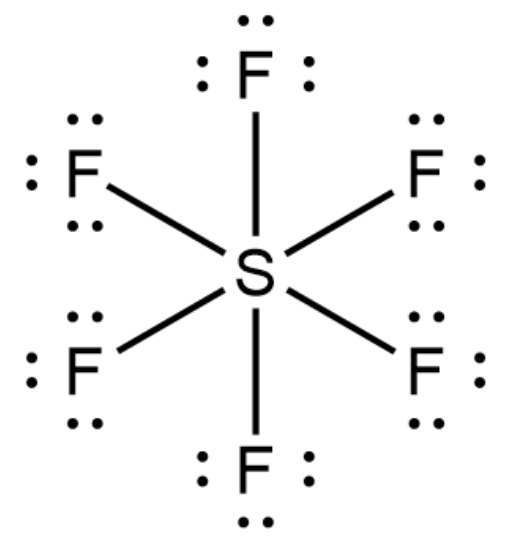
A correct Lewis structure will show which atoms are bonded to which other atoms and account for all of the valence electrons. A Lewis structure may be adapted to show the shape of the molecule, but the molecular shape is not necessarily shown in a Lewis structure. We use Valence Shell Electron Pair Repulsion theory to predict the shape of the molecule from its Lewis structure.
Consider the molecule sulfur hexafluoride shown here.
Is SF 6 a nonpolar, ionic, or polar compound?
- Polar
- Nonpolar
- Ionic

Nonpolar
Ex.
SF 6 is a nonpolar compound.
The S-F bonds are polar because of their difference in electronegativity values. Due to the molecular geometry (shape) of the molecule, which is octahedral, the polarity of the bonds results in a net dipole moment of zero so the molecule is nonpolar.
A correct Lewis structure will show which atoms are bonded to which other atoms and account for all of the valence electrons. A Lewis structure may be adapted to show the shape of the molecule, but the molecular shape is not necessarily shown in a Lewis structure. We use Valence Shell Electron Pair Repulsion theory to predict the shape of the molecule from its Lewis structure.
What is the electron geometry of IF 4 + ?
- Seesaw
- Square planar
- Trigonal bipyramidal
- Tetrahedral

Trigonal bipyramidal
Ex.
The electron geometry of IF 4 + is trigonal bipyramidal . A molecule with four bonded atoms and one lone pair on the central atom will assume a trigonal bipyramidal electron geometry.
A molecule with four bonded atoms and no lone pairs on the central atom will assume a tetrahedral electron and molecular geometry. A molecule with four bonded atoms and one lone pair on the central atom will assume a trigonal bipyramidal electron geometry and a seesaw molecular geometry. A molecule with four bonded atoms and two lone pairs on the central atom will assume an octahedral electron geometry and a square planar molecular geometry.
A correct Lewis structure will show which atoms are bonded to which other atoms and account for all of the valence electrons. A Lewis structure may be adapted to show the shape of the molecule, but the molecular shape is not necessarily shown in a Lewis structure. We use Valence Shell Electron Pair Repulsion theory to predict the shape of the molecule from its Lewis structure.
The molecular geometry (shape) of CCl 4 is __________.
- Trigonal pyramidal
- Linear
- Trigonal planar
- Tetrahedral

Tetrahedral
Ex.
The molecular geometry (shape) of CCl 4 is tetrahedral . A molecule with four bonded atoms and no lone pairs on the central atom will assume a tetrahedral electron and molecular geometry.
A molecule with two bonded atoms and no lone pairs on the central atom will assume a linear electron and molecular geometry. A molecule with three bonded atoms and no lone pairs on the central atom will assume a trigonal planar electron and molecular geometry. A molecule with three bonded atoms and one lone pair on the central atom will assume a tetrahedral electron geometry and a trigonal pyramidal molecular geometry.
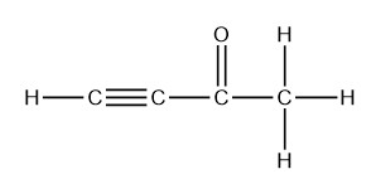
How many ơ and π bonds are found in 3-butyn-2-one?
- 8 ơ and 5 π
- 5 ơ and 3 π
- 5 ơ and 5 π
- 8 ơ and 3 π
8 ơ and 3 π
Ex.
There are 8 ơ and 3 π bonds in 3-butyn-2-one.
A single bond is a ơ (sigma) bond, a double bond is composed of one ơ and one π(pi) bond, and a triple bond is composed of one ơ and two π bonds. The molecule contains six single bonds, one double bonds, and one triple bond. Six single bonds are six ơ bonds, the double bond is one ơ bond and one π bond, and a triple bond is one ơ bond and two π bonds for a total of eight ơ bonds and three π bonds.
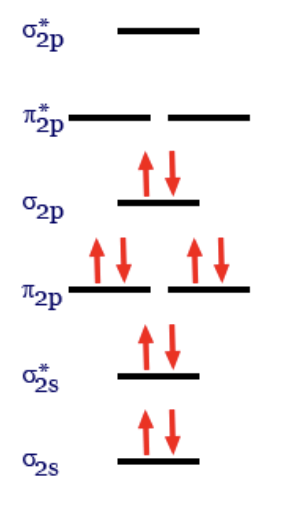
There are 10 valence electrons in the homonuclear diatomic molecule N2. Molecular orbital theory predicts the following occupation of the orbitals.
What is the bond order of N 2 ?
- 6
- 2
- 1
- 3
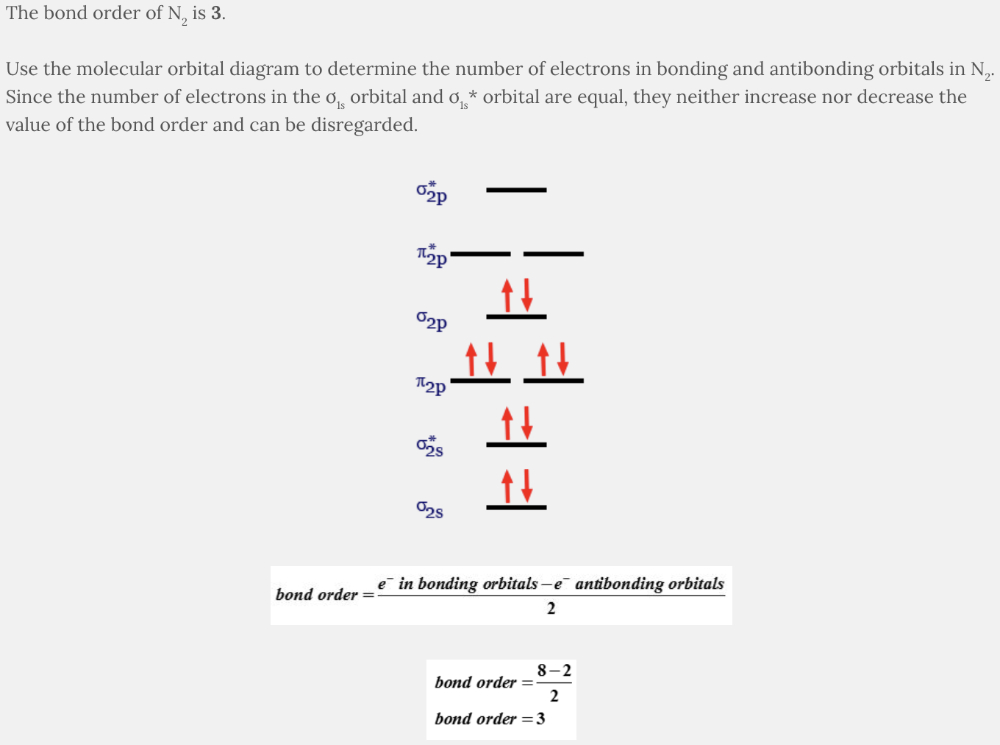
3
What type of bonds form a double bond?
- Two pi bonds
- Two sigma bonds
- One sigma bond and one pi bond
- One pi bond
One sigma bond and one pi bond
Ex.
A double bond forms from one sigma bond and one pi bond .
A sigma bond occurs from the overlap of two s orbitals, two hybrid orbitals, or the end-to-end overlap of two p orbitals. A pi bond occurs in the side-to-side overlap of p orbitals. Double bonds are formed from one sigma bond and one pi bond. A single bond is one sigma bond; a double bond is composed of one sigma bond and one pi bond; and a triple bond is composed of one sigma bond and two pi bonds.